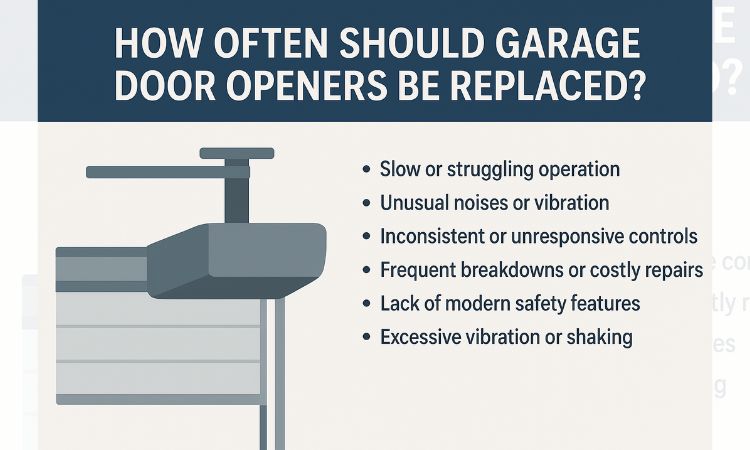Your garage door opener is one of the most essential yet overlooked components of your home. It provides safety, convenience, and security every time you open or close your garage door. Yet, many homeowners take it for granted often waiting until it breaks down completely before thinking about replacement.
Knowing how often a garage door opener should be replaced can help you avoid unexpected failures, costly emergency repairs, and even potential safety risks. In this guide, we’ll cover everything you need to know: the average lifespan of an opener, warning signs it’s wearing out, and how to extend its life through proper care and maintenance.
Introduction: Why Knowing When to Replace a Garage Door Opener Matters
A garage door opener is more than just a convenience it’s a key part of your home’s safety and daily function. It allows you to access your garage securely, protects your belongings, and prevents unauthorized entry. However, like any mechanical device, it has a limited lifespan.
Many homeowners overlook the signs of a failing opener until it completely stops working, leaving them stranded or locked out. Regularly assessing the condition of your opener ensures smoother performance, greater safety, and peace of mind.
In this article, we’ll explore how long garage door openers last, the factors that affect their lifespan, the warning signs that signal it’s time for a replacement, and tips to prolong the life of your new opener.
Average Lifespan of a Garage Door Opener
On average, a garage door opener lasts between 10 and 15 years. However, this number varies depending on how often it’s used, how well it’s maintained, and what type of opener you own.
A garage door opener goes through “cycles” one cycle equals one opening and one closing. A typical household may use the garage door 3–5 times daily, meaning your opener performs over 1,000 cycles a year. Over time, these cycles cause wear on gears, motors, and chains.
Different Types of Garage Door Openers and Their Lifespan:
- Chain-Drive Openers: Known for durability but require more maintenance; lifespan of 10–12 years.
- Belt-Drive Openers: Quieter operation and fewer moving parts; lifespan of 12–15 years.
- Screw-Drive Openers: Powerful and low-maintenance; lifespan around 10–13 years.
If your opener is approaching or exceeding a decade of use, it’s wise to have it inspected to ensure it’s still performing safely and efficiently.
Factors That Affect How Long a Garage Door Opener Lasts
Several factors can influence how quickly your opener wears out. Understanding these can help you make it last longer.
- Usage Frequency: The more you use your garage door each day, the faster its motor and internal components wear out. Heavy daily use accelerates cycle count, shortening the opener’s lifespan.
- Maintenance Quality: Regular maintenance such as lubrication, tightening of screws, and balance testing can add several years to your opener’s life. Neglecting maintenance leads to friction, stress, and early motor wear.
- Type and Build Quality: High-end openers with DC motors or smart systems tend to last longer than basic AC models. Investing in a reputable brand can reduce repair frequency.
- Environment: Climate plays a big role. High humidity, dust, or extreme temperatures can corrode metal parts and degrade electrical components.
- Installation Quality: Poor installation can cause unnecessary strain on gears and tracks. Always hire a qualified technician to ensure the opener is properly aligned and mounted.
Warning Signs That It’s Time to Replace Your Garage Door Opener
Even if your opener hasn’t completely failed, there are several clear signs that it’s reaching the end of its life.
Slow or Struggling Operation
If your door opens slower than usual or hesitates during movement, it could mean motor fatigue or worn gears. While minor issues might be fixable, persistent sluggishness is often a sign that replacement is needed.
Unusual Noises or Vibration
Grinding, rattling, or buzzing sounds usually point to worn drive mechanisms or loose hardware. While some noise is normal, excessive vibration may indicate internal wear or impending failure.
Inconsistent or Unresponsive Controls
If your remote or wall control works intermittently, it may not be just a battery issue. Electrical faults or outdated receivers can cause unresponsiveness, especially in older openers that lack modern radio frequency systems.
Frequent Breakdowns or Costly Repairs
A good rule of thumb: if repair costs exceed 50% of the price of a new unit, replacement is more cost-effective. Constant service calls are a sign your opener is at the end of its useful life.
Lack of Modern Safety Features
Garage doors manufactured before 1993 may lack auto-reverse sensors, rolling code technology, and manual release mechanisms features that protect your family and property. If your opener lacks these, it’s time to upgrade.
Excessive Vibration or Shaking
If the unit shakes excessively while operating, it could be due to worn internal gears or loose mounting. Over time, this can damage both the opener and the door system itself.
Benefits of Replacing an Old Garage Door Opener
Replacing an aging opener isn’t just about fixing a mechanical issue it’s an opportunity to enhance your home’s safety, comfort, and efficiency.
Improved Safety
Modern openers include photo-eye sensors that prevent the door from closing on people or objects, drastically reducing accident risks.
Enhanced Security
New openers use rolling code technology, which generates a unique access code each time you use your remote preventing hackers from duplicating your signal.
Smart Connectivity
Wi-Fi-enabled openers allow control from your smartphone or voice assistant, giving you real-time access and monitoring, even while away from home.
Quieter Operation
If your current opener shakes the whole house when it runs, a new belt-drive or DC motor model will offer whisper-quiet performance.
Energy Efficiency
Modern openers consume less standby power and use energy-efficient motors, saving money in the long term.
When Replacement Is Better Than Repair
There comes a point when continuing to repair an old opener no longer makes financial or safety sense.
- Cost Comparison: Frequent small repairs quickly add up. If your opener is 10+ years old, replacement often costs less over time.
- Parts Availability: Many older models have discontinued parts, making future repairs difficult or impossible.
- Technological Advances: Today’s openers come with smart features, enhanced safety sensors, and quieter designs benefits older models simply can’t match.
If your opener is outdated, noisy, or unreliable, upgrading is the most practical long-term solution.
Tips to Extend the Life of Your New Garage Door Opener
A new opener can easily last beyond its expected lifespan with proper care. Follow these best practices:
- Lubricate moving parts every 3–6 months using silicone-based lubricant.
- Tighten hardware such as bolts, nuts, and brackets to prevent vibration damage.
- Keep sensors clean and aligned to avoid operational errors.
- Avoid overloading the door with unnecessary weight or insulation panels.
- Replace remote batteries annually to prevent signal strain.
- Schedule annual professional tune-ups to inspect balance, springs, and electrical systems.
Routine care not only saves money but also ensures consistent, safe performance.
Choosing the Right Replacement Garage Door Opener
When it’s time for a new opener, selecting the right one for your garage’s size and needs is key.
Common Types of Garage Door Openers:
- Chain-Drive Openers: Affordable and strong but noisier best for detached garages.
- Belt-Drive Openers: Quieter and ideal for attached garages near living spaces.
- Screw-Drive Openers: Low maintenance and powerful, suitable for heavy doors.
Tips for Choosing the Right Opener:
- Match motor strength to door weight (½ HP for single doors, ¾–1¼ HP for double or insulated doors).
- Opt for smart-enabled models for remote operation and notifications.
- Look for brands offering warranty coverage and reliable customer support.
Conclusion: Stay Proactive for Safety and Performance
A well-maintained garage door opener typically lasts 10 to 15 years, but usage habits, environment, and maintenance can shorten or extend that life. Being proactive by recognizing warning signs early, performing regular maintenance, and upgrading when necessary— nsures your home remains safe and your opener performs efficiently.
Don’t wait until your opener fails unexpectedly. Have a local garage door technician inspect it regularly to determine whether it’s time for a replacement or simple maintenance.
Contact a professional today to keep your garage door system operating safely, quietly, and reliably for years to come.
FAQ Section (SEO Boost)
Q1. What is the average lifespan of a garage door opener?
Most openers last 10–15 years, depending on usage, quality, and maintenance.
Q2. How do I know if my garage door opener needs to be replaced?
Watch for slow movement, strange noises, unresponsive controls, or frequent breakdowns.
Q3. Can a garage door opener last 20 years?
Yes, with proper care and light use, but technology and safety features often make early replacement worthwhile.
Q4. Should I replace my garage door opener or repair it?
If your opener is more than 10 years old and repairs are frequent or costly, replacement is the smarter long-term choice.













































